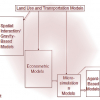Free Online Productivity Tools
i2Speak
i2Symbol
i2OCR
iTex2Img
iWeb2Print
iWeb2Shot
i2Type
iPdf2Split
iPdf2Merge
i2Bopomofo
i2Arabic
i2Style
i2Image
i2PDF
iLatex2Rtf
Sci2ools
Publication
Models of Transportation and Land Use Change: A Guide to the Territory
Modern urban regions are highly complex entities. Despite the difficulty of modeling every relevant aspect of an urban region, researchers have produced a rich variety of models dealing with interrelated processes of urban change. The most popular
types of models have been those dealing with the relationship between transportation network growth and changes in land use and the location of economic activity, embodied in the concept of accessibility. This article reviews some of the more common frameworks for modeling transportation and land use change, illustrating each with some examples of operational models that have been applied to real-world settings. It then
identifies new directions for future research in urban modeling and notes the important contributions of the field to date.
| Added | 09 Feb 2009 |
| Updated | 09 Feb 2009 |
| Type | Journal |
| Year | 2008 |
| Where | Journal of Planning Literature |
| Authors | Michael Iacono, David Levinson, Ahmed El-Geneidy |
Comments (0)




